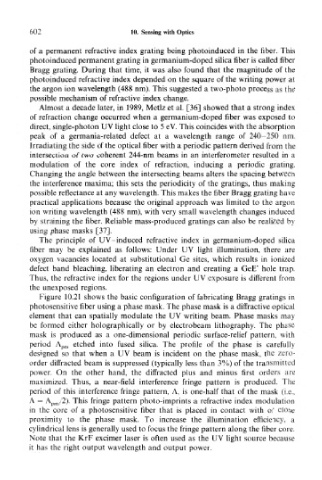Page 618 - Introduction to Information Optics
P. 618
602 10. Sensing with Optics
of a permanent refractive index grating being photoinduced in the fiber. This
photoinduced permanent grating in germanium-doped silica fiber is called fiber
Bragg grating. During that time, it was also found that the magnitude of the
photoinduced refractive index depended on the square of the writing power at
the argon ion wavelength (488 nm). This suggested a two-photo process as the
possible mechanism of refractive index change.
Almost a decade later, in 1989, Metlz et al. [36] showed that a strong index
of refraction change occurred when a germanium-doped fiber was exposed to
direct, single-photon UV light close to 5 eV. This coincides with the absorption
peak of a germania-related defect at a wavelength range of 240-250 nm.
Irradiating the side of the optical fiber with a periodic pattern derived from the
intersection of two coherent 244-nm beams in an interferometer resulted in a
modulation of the core index of refraction, inducing a periodic grating.
Changing the angle between the intersecting beams alters the spacing between
the interference maxima; this sets the periodicity of the gratings, thus making
possible reflectance at any wavelength. This makes the fiber Bragg grating have
practical applications because the original approach was limited to the argon
ion writing wavelength (488 nm), with very small wavelength changes induced
by straining the fiber. Reliable mass-produced gratings can also be realized by
using phase masks [37].
The principle of UV-induced refractive index in germanium-doped silica
fiber may be explained as follows: Under UV light illumination, there are
oxygen vacancies located at substitutional Ge sites, which results in ionized
defect band bleaching, liberating an electron and creating a GeE' hole trap.
Thus, the refractive index for the regions under UV exposure is different from
the unexposed regions.
Figure 10.21 shows the basic configuration of fabricating Bragg gratings in
photosensitive fiber using a phase mask. The phase mask is a diffractive optical
element that can spatially modulate the UV writing beam. Phase masks may
be formed either holographically or by electrobeam lithography. The phase
mask is produced as a one-dimensional periodic surface-relief pattern, with
period A pm etched into fused silica. The profile of the phase is carefully
designed so that when a UV beam is incident on the phase mask, the zero-
order diffracted beam is suppressed (typically less than 3%) of the transmitted
power. On the other hand, the diffracted plus and minus first orders are
maximized. Thus, a near-field interference fringe pattern is produced. The
period of this interference fringe pattern, A, is one-half that of the mask (i.e.,
A = A pm/2). This fringe pattern photo-imprints a refractive index modulation
in the core of a photosensitive fiber that is placed in contact with or close
proximity to the phase mask. To increase the illumination efficiency, a
cylindrical lens is generally used to focus the fringe pattern along the fiber core.
Note that the KrF excimer laser is often used as the UV light source because
it has the right output wavelength and output power.

